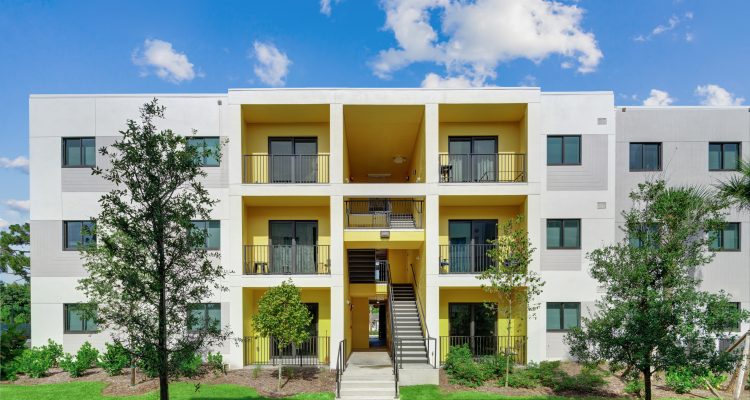A 96-unit, four-building apartment complex in West Palm Beach, Fla., is going up in record time – approximately eight weeks per building – thanks to a patented mineral composite fiber reinforced (MCFR) building system from RENCO USA Inc. While the construction is rapid, testing and approvals of the MCFR building system were lengthy. RENCO USA has spent more than a decade getting its material certified for use in the United States under the International Building Code and within the stringent requirements for High Velocity Hurricane Zones in the Florida Building Code.
Inspired by Legos® and traditional concrete masonry units (CMUs), the interlocking building system was initially developed by Engin Yesil, RENCO USA co-founder, and has been in use in Turkey since 2012. The system was brought to the U.S. by Tom Murphy, Jr., RENCO co-founder and CEO of Coastal Construction Group, the company spearheading the West Palm Beach demonstration project.
“One of our biggest hurdles to get through is now probably one of our biggest attributes and assets,” says Patrick Murphy, executive vice president of Coastal Construction. “We’ve already gone through 400-plus tests and a decade of testing to get these approvals.” Now, RENCO’s products can be used like other traditional building materials, without the need to secure engineering evaluation reports for their use on every project.
The MCFR building blocks are a patented blend of chopped roving; continuous filament mat; post-consumer, re-purposed resin; and calcite. The resulting mix lends itself to an incredibly strong building system.
“A typical CMU will break under a compressive load of about 1,600 psi. Our blocks break at 16,000 psi,” says Ken Smuts, president of RENCO USA. “A typical masonry block doesn’t have any tensile strength other than the rebar you put in it. Our blocks have 5,000 psi of tensile strength, and we have 14,000 psi of flexural strength.”
Components are fabricated through a combination of processes. Sill plates are formed through compression molding, while injection molding is used to manufacture the 8 x 8 x16-inch hollow blocks that are stacked to form the structural walls. Linear elements – including joists, bridging, decking, lintels, window and door bucks, and cap pieces – are pultruded. In the field, each component of the system is joined with a methyl methacrylate adhesive, creating a chemical bond that requires no additional reinforcement.
Smuts says that the light weight of the system delivers significant installation advantages. Because a RENCO block weighs about 8.5 pounds, compared to a typical CMU’s 40 pounds, the product requires minimal use of heavy machinery on the job site. Laborers assemble blocks by hand until the walls are approximately waist height. Then they climb on a rolling baker scaffold and erect the remainder of the project from inside the building. Lifts raise the pallets of material to working level, and blocks are assembled using only a mallet and a glue gun. There is no measuring or cutting required.
As the walls go up, the builders have noticed an additional advantage: The material doesn’t wick water – it repels it. “Here in Florida, it rains two hours every afternoon and it’s as hot as can be,” says Smuts. “We’ve built concrete buildings throughout the state, and they are super humid and tough to work in during the summer months.”
The MCFR block, on the other hand, remains dry. “It seems cool. There’s no humidity in the building, so the trades enjoy working in it,” Smuts says.


